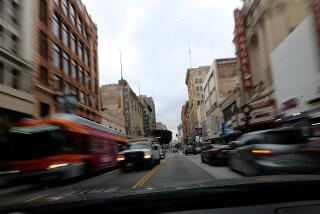Clock Repairs Big Business Since Quake
In a dusty and sprawling warehouse redolent of centuries-old hardwood and lit with the reflections of tarnished brass, Father Time stands still.
The job of the 25 craftsmen is to get the rickety old man moving again.
They are clockmakers, and not one of the 1,040 grandfather clocks that fill the 10,000-square-foot shed ticks or tocks or chimes. Not a pendulum swings. And not a hand moves from its position marking that fateful hour: 4:31 a.m.
Earthquake time.
“I’d pick a clock off the floor and it would read 4:36, and I’d say, ‘Hey, your clock was fast,’ ” master clockmaker Mark Katz said with a chuckle, recalling the morning of the Jan. 17 Northridge earthquake.
At Cal West Clock Emporium in Van Nuys, a business almost exclusive to Southern California is booming: grandfather clock repair. After all, store co-owner Tony Vitale said, where else are the massive timepieces rocked off their bases, sent hurling down a flight of stairs, through a living room window and into the front yard?
The shop’s former home was in Northridge, near the quake’s epicenter, and many of its own clocks were shattered by the quake.
Working 12 or 15 hours a day, six days a week for the last eight months, the artisans have repaired and sent home about 300 grandfathers--as well as 500 mantle and wall clocks at another nearby shop. More than 1,300 still stand silent in their quake-induced comas.
It is an almost eerie sight, the warehouse: part hospital, part workshop, part morgue.
There is a stately Colonial made of curly oak, split almost in two. Another of black mahogany stands gutless, its movement, or mechanism, in a box on the ground. A hand-painted, 150-year-old dial lies motionless on a workbench.
If some are so close to clock death, Vitale thought right after the temblor, why not euthanasia? After 30 years in the clock business, he had begun to believe that “a clock’s a clock. It’s just a timepiece,” he said.
And then owners began scurrying nervously about as workers came to pick up their clocks, asking for the prognosis and literally saying goodby, aloud.
“I found out just how important they are,” Vitale said. “I felt like an undertaker.” For most, cost was no issue--$500, $1,000, $2,000. Just fix it, they said. Even the woman with the 250-year-old clock-organ that plays nine German classics didn’t balk at the $7,000 estimate. Of course, the antique is valued at $45,000, but that is only half the concern, Vitale said.
Once carted off, owners would call to check on their clocks. “How’s my buddy?” one inquired. “Is he almost done?”
Before the quake, turnaround time for major repair was four to six weeks. It quickly became four to six months, and owners began asking if they could stop by and see their clocks. After enough requests, Vitale accommodated: Visiting hours are 2 to 4 p.m., Monday through Friday.
One woman found another way to bear the extended absence of her prized grandfather: She built a cardboard replica, complete with movable hands.
More to Read
Sign up for Essential California
The most important California stories and recommendations in your inbox every morning.
You may occasionally receive promotional content from the Los Angeles Times.









